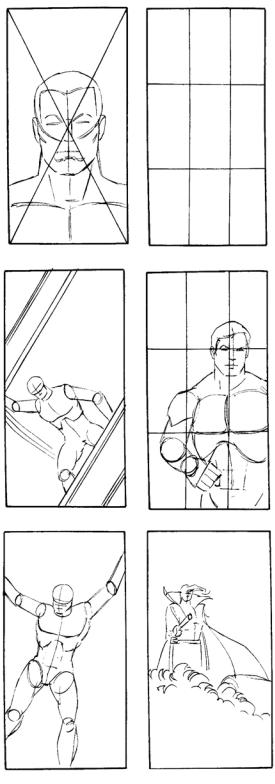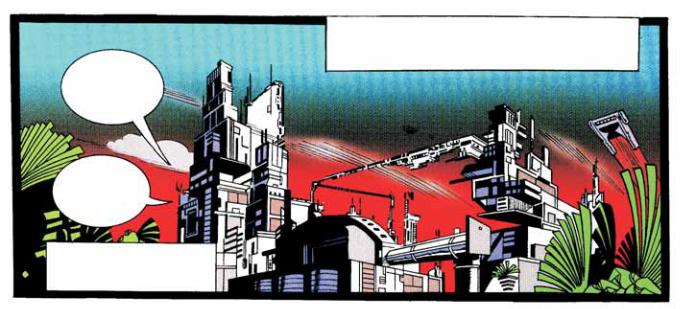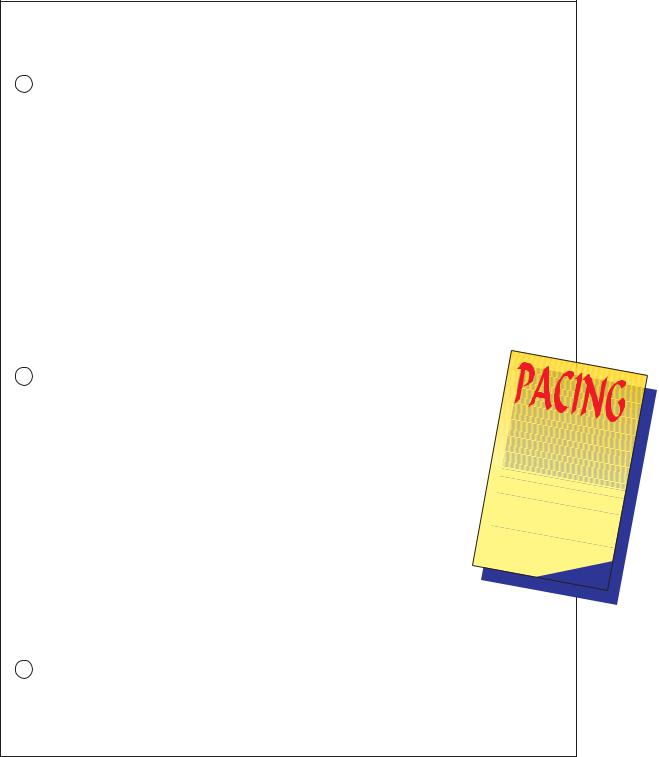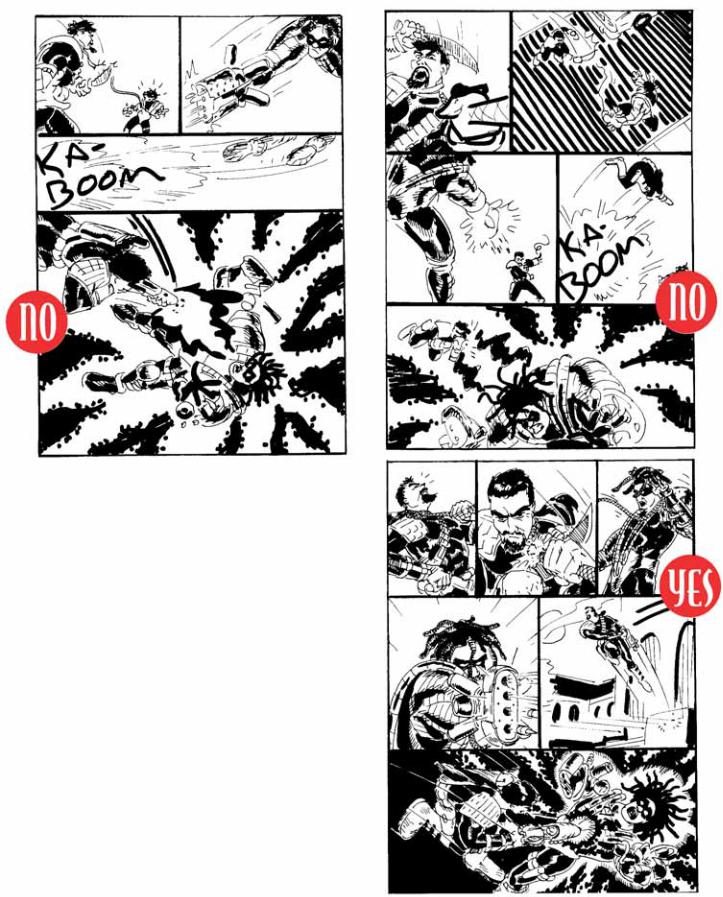
- •Acknowledgments
- •Contents
- •Introduction
- •The Contributing Artists
- •Sketching Different Head Shapes
- •Facial Features
- •How to Draw Hair
- •Popular Comic Book Expressions
- •Grimaces
- •Anatomical Proportions
- •Body Basics
- •Building an Action Pose
- •The Action Figure, Step By Step
- •The Heroic Female Figure
- •Anatomy of the Hand
- •Basic Hand Poses
- •Heroic Hands
- •Female Hands
- •Turnarounds
- •Devastating Punches
- •Clean Punches
- •The Lunge Attack
- •Leaning Into the Punch or Kick
- •The Judo Shoulder Throw
- •David vs. Goliath
- •The Balance of Power
- •The Renegade Soldier
- •Sword-and-Sorcery Villains
- •Forces of Evil
- •Inventing a Villain
- •Beastly Villains
- •Hollywood Heavies
- •Dressed to Kill
- •Unearthly Creatures
- •Comic Book Beauties Then...
- •Femme Fatales Yesterday...
- •...And Today
- •Denizen of the Street
- •Beauty in All Shapes and Colors
- •Drawing from Photos
- •Good Gal Heroes
- •Strong But Sexy
- •A Hint About Skintight Costumes
- •One-Point Perspective
- •Two-Point Perspective
- •The Horizon Line and the Figure
- •Multiple Figures in Perspective
- •Hanging Figures on a Horizontal Line
- •Creating Volume with Perspective
- •Dynamic Angles
- •From Start to Finish
- •Using Pattern and Value
- •Special Effects in Space
- •Bursts
- •Putting It All Together
- •Effective Composition
- •The Establishing Shot
- •What a Comic Book Script Looks Like
- •Thumbnail Sketches
- •The Rough Layout
- •Preparing a Pencil Layout for Inking
- •The Final Inked Page
- •Inking Like a Pro
- •Stuff You Need to Know
- •Art Supplies Shopping List
- •Reflections
- •Light Source
- •Shading
- •Varying An Ink Line
- •Folds and Drapery
- •Designing Costumes
- •Rapid Fire
- •In The Crosshairs
- •Hidden Danger
- •Aggressive Assault Vehicles
- •Off-Road
- •Mean Machines
- •Sky Patrol
- •Fighter Planes
- •How Things are Supposed To Get Done
- •How to Get Your First Job
- •Interview With A Noted Comic Book Editor and Publisher

effective composition
he secrets of effective composition are shared |
aren't positioned well in relationship to each other, |
Tamong professionals but are rarely found in |
the reader, the background, or the panel that |
how-to books. Yet, these rules are essential if you |
frames the scene, then it won't have the impact |
want to create powerful images. You can render |
you're striving for. Don't rob yourself of the effect |
the most exquisite drawing, but if the figures |
you've been working so hard to achieve. |
DON’T!
...put the dominant element in the center.
It's just not dynamic.
DON’T!
...cut off corners. It's a sign of an amateur. Instead of making the picture more interesting, you've succeeded
only in making triangles in the corners of the panel. Less tilt would actually make the drawing more dramatic.
DON’T!
...cut off hands and feet. What it tells the reader is, "Oh, this guy can't draw hands and feet.”
DO!
...divide a panel by three both horizontally and vertically, for a total of nine equal sectors. This is a painter's and illustrator's trick for creating dynamic compositions, and it's worth the price of the book alone.
DO!
...place the center of interest at any point where these lines intersect. In this case we've placed the hero's head at the intersection of the right vertical
and top horizontal guidelines.
DO!
... vary your compositions. This is a longer shot using the same principle, but whose point of emphasis falls at the intersection of the
left vertical and top horizontal guidelines.

the establishing shot
The establishing shot does just that: It establishes a scene or the positions of different characters
by showing them from a distance where everything and everybody is visible. If you didn't have an establishing shot and used only close-ups, before long the reader would be lost and unable to identify the context in which the scene takes
place. On the other hand, too many establishing shots make a story remote and inaccessible because the reader is kept at a distance from the characters.
An establishing shot doesn't always have to be at the beginning of a story, although that's usually the case. Sometimes an establishing shot, like the one below, is used in the middle of a story to
"widen it out" and let it breathe. You might be illustrating dialogue that takes place in an office, but an office interior can become claustrophobic, so you cut to the exterior of the office and show the city to give the scene some breathing room. In the example below, the exterior is a futuristic city. This professional technique breaks up the monotony and helps to keep the reader's interest.
Notice how the dialogue balloons appear to be coming from the office building, but their spouts aren't coming from any particular window. They simply indicate that the dialogue is coming from the general area of the office, and the point comes across clearly.

what a comic book script looks like
Each comic book script is different. While some writers offer lots of descriptive detail, others provide very few clues as to how a scene should look. The role
of the comic book penciler is part interpreter, part creator. He or she must find the most exciting and effective way to tell the story.
HERO VERSUS VILLAIN/SPECIAL ISSUE, VOLUME III
PAGE 4
Our Hero reels in agony as the huge, other-worldly villain shoots a cable around his neck, strangling him. Hero grabs knife from his belt and slashes the cable, breaking free. He is now one ticked off guy. He's ruffled, not the smooth, untouchable fighter we are used to seeing. The Hero gives Villain his famous glare of bad intentions.
If that won't kill the Hero, this will: with his free hand, the Villain quickly pulls out a heavy gun that FIRES four missiles all at once! The missiles race toward our Hero.
Hero leaps into the air - and I mean acrobatics - just as the missiles explode at the exact point where he was.
Hero suddenly spins, and with a solid two-handed grip, fires his blaster into Villain's body. Villain is right behind Hero, one more moment, and Hero would have been Spam. A huge explosion fills the panel. Villain is blown back -- the weapon goes flying out of his hand. Nothing could survive that.
PAGE 5 |
|
|
|
|
|
|
|
|
|
|
|
|
|
Hero slumps to his knees, in the middle of the city street. |
|
|
|
|
|
|
|
|
|
|
|
|
|
Villain lays next to him, face down, gone. Hero is exhausted. |
|
|
|
|
|
|
|
|
|
|
|
|
|
Crowds peer. Life coming back to the street. Hero |
|
|
|
|
|
|
|
|
|
|
|
|
|
whispers: "It's over..." |
|
|
is also |
|
|
|
|
|
|
|
|||
|
|
|
important. |
||||||||||
Villain's arm lays dormant as we see the Hero walking away in theIf |
every |
||||||||||||
background. |
|
|
|
|
|
|
panel is |
|
|||||
|
|
explosion, |
|
|
|
an |
|||||||
|
|
|
then |
|
|||||||||
The Hero gets on his motorcycle, kick starts it and it hums He |
reader |
will |
|
the |
|||||||||
looks at a kid who is looking at him.Kid says, "Gee mister, I |
|
weary |
|
|
become |
||||||||
|
after |
||||||||||||
|
|
|
|
|
|
|
|||||||
thought you was gonna get killed. |
|
pages, |
a |
few |
|
|
|||||||
|
|
and |
|
|
|
||||||||
|
|
|
|
|
|
||||||||
|
|
|
|
|
the |
|
|
||||||
Hero says, "Thanks for having so much confidence in me. |
|
explosions |
|
|
|
||||||||
|
|
|
|
|
|
|
will |
|
|
||||
Kid says,"Do you think you could beat him if you fought him |
lose |
their |
|
|
|
||||||||
|
|
|
|
|
|
|
|
|
|
||||
again? |
(pardon |
|
“pow” |
|
|
||||||||
the |
pun). |
|
|
||||||||||
|
|
|
|
|
|
||||||||
|
|
|
|
|
|
|
|||||||
|
|
|
|
|
|
|
|
|
|
||||
WE SEE THE VILLAIN'S FINGER TWITCH. The fat lady didn't sing yet.
Hero says, "Why do you want to know that?"
Kid says, "Because he's right behind you!"
And with that, the Villain rises, grabs the motorcycle the Hero is sitting on, and hurls him into the side of a building!

thumbnail sketches
When a penciler starts laying out a page from a script-in this case, page 4-he has many
options. He begins by sketching a variety of approaches without committing to any. Some he'll save, some he'll combine, and some he'll tear up into teensy little pieces.
Thumbnail sketches are small, quick sketches that show the sequence and general direction of a series of images. It's very important that you don't fall in love with your thumbnail sketches. This would defeat their purpose, which is to give an artist the freedom to throw them away or change them. You're seeking ideas at this point, not finished drawings.
The approach above, left, doesn't show enough of the characters' faces to make the action compelling.
The approach above, right, has wonderful dramatic angles. But the characters are still too far away to pull us into the story.
The approach at right combines medium shots and close-ups with a variety of interesting angles. It's a keeper.
